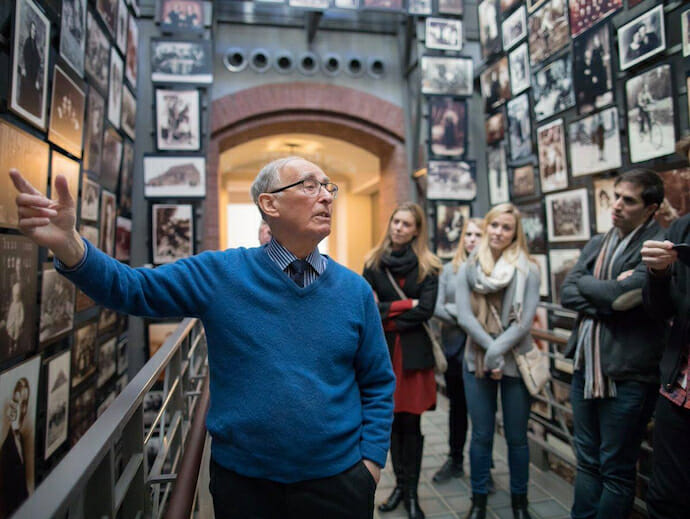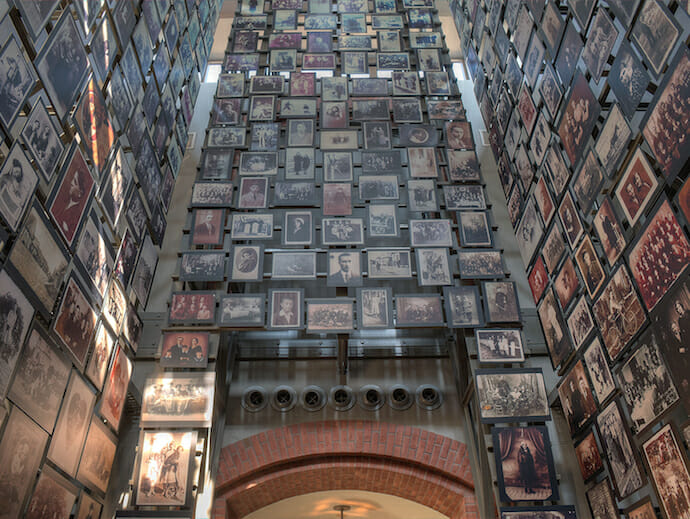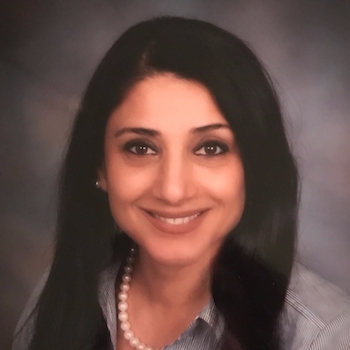
Culture
The United States Holocaust Memorial Museum in Washington D.C.
According to the museum administrators, the purpose of the United States Holocaust Memorial Museum is not only to educate people about how millions of people were murdered during the Holocaust and document, study, and interpret the Holocaust history, but also to help world leaders and citizens combat hatred, racism and discrimination, and prevent genocide by promoting human rights and democracy.
My daughter accompanied me. It was her first visit. My first reaction was to the interior design of the building, an old-fashioned structure, steel plates with bolted metal and enormous posts that are purposely designed to convey the tragic themes of the Holocaust and to convey fear, sadness and discomfort in visitors’ heart. I instantly remembered Iraqi’s Abu Ghraib prison when Saddam Hussein was in power; the prison was a center of human right’s violations. Furthermore, after the invasion of Iraq, the world witnessed a series of crimes committed by the personnel of the U.S. Army and the Central Intelligence Agency including physical and sexual abuse, torture, sodomy, rape and most of the vicious acts ended in the murder of the detainees in the Abu Ghraib prison.
“Holocaust” is a word of Greek origin meaning “sacrifice by fire.” The Holocaust is one of the most horrendous crimes ever committed against humanity. As we enter middle school, as early as age thirteen, we start learning about the Holocaust in classrooms and textbooks. They basically teach that in the 1940s, the German Nazi party, led by Adolph Hitler, purposefully performed a mass genocide in order to attempt to breed a perfect Aryan population. Although, the mass genocide focused on the Jews in Germany, because Jews were deemed to be racially inferior as well as a threat to the German community, yet, other groups were targeted based on their political, ideological and behavior like Communists, Socialists, Jehovah’s Witnesses, and homosexuals.
After a man in a maroon blazer “Museum staff member” scanned our entry tickets, he asked us to pick an ID-card of the victims and survivors of the Holocaust. We would later find out if the person had lived or died in the mass-killings. We were then asked to ride the elevator to go to the 4th floor. The tour began from the top floor down. When the elevator door opened, misery was displayed by two huge chilling displays of the torture and suffering of the people at the hands of the Nazi’s. The first item to catch my attention was a sample of the pajama like blue and white stripe prison clothes.
Small monitors were playing videos of happy times and normal daily life before the Holocaust. Videos of old people dancing and laughing and young children playing games. Additionally, some monitors projected photos of weddings and businesses. I was smiling looking at the Jews as they lived a normal life, until I turned around. My emotions changed to sadness as I experienced the transformation of the meaning of human value, human rights, acceptance and unity. In 1933 more than 9 million Jews lived in Europe, in less than a decade, most of the countries where they lived were invaded.

In January 30, 1933, when Adolph Hitler was appointed to generate or restore democracy that was at risk from 1920 – 1930s. University students were among those who supported of the Nazi’s regime. The horror began. The Nazi’s ordered the Germans to only shop at German shops and stop buying products from the Jews, but most German people did not obey the order and continued doing business with the Jews. “One people, one state, and one leader” was the slogan.
Starting in 1934, young boys were brainwashed and became vehicles for the regimentation and indoctrination of German boys, as for girls, they were pressured into leagues of German girls. German boys and girls were encouraged to hang out together and have babies with no marriage required. In 1935, the Nazis used malicious methods to minimize the Jews, one method was through the boycott to close Jewish shops. A political rally of Nuremberg Laws, indicated that in order to contribute to society an individual must be pure German. Because of one non-German parent, many people lost their citizenship. The Nazi’s used propaganda along with terror, through books, films, and movies for children, their ultimate goal was to brainwash Germans.
A huge poster holding pictures of several men’s faces displays a man on the left representing a perfect German with blue eyes and blonde hair: the superior race. Germans were forced to avoid any association with the Jews and other people of color by segregating them from each other. Just shortly after the 1933 Nuremburg laws separation created a new culture, Jews were prohibited from working in certain professions and renting or owning homes in many places. They could not retain their financial assets and could not move freely. This led to the separation of 10,000 kids from their parents, most of whom never reunited with their parents again.
A political cartoon entitled “Will the Evian Conference Guide him to Freedom?” was published in the New York Times in July 3, 1938. I was quiet for minutes. The cartoon spoke to me, I heard pain, anguish, violation of human rights, distress, hopelessness, anger, hunger, medical issues, loneliness, lack of trust and above all he is homeless, dispossessed, and surrendered, sitting on his limited belongings, head down, unshaved with weak knees unable to stand up. He spoke to me and said he is a symbol of thousands of the refugees who far exceed the opportunities, both legal and illegal, to emigrate. Delegates from 32 countries met in Evian, France, to discuss how to respond to the refugee crisis. The representatives expressed remorse about the troubles of refugees, but a majority said that they were unable to increase their countries’ immigration quotas, due to a worldwide economic depression. After the Evian conference, Hitler concluded, “Nobody wants these criminals.” This particular image display caught my attention and I will remember it for a long time because I could relate to him. Did he die? Or did he surrender once again and continue to obey by the Nazi’s orders? Or did he survive and was able to find a new country? Or was he pulled into one of the death camps? I lived 24 years of my life in Kurdistan “Northern Iraq” without an identity or a country, my family was one of the many families forced to take orders from someone who is not even our leader. We had no freedom, no safety, and no gratitude. I thought becoming a refugee will give me a status with a sense of freedom and that I will soon feel that the U.S. is my country, I tried hard, but that was not the case. To pull out a 24 years old tree where its roots are sprouted under the ground and then you want to implant it in another completely strange soil, most likely, the tree will struggle to cultivate new roots and new growth, let alone to feel it belongs to the new land and can call my country “home.”

My jaw dropped when I saw a metal bed that once an ill or a handicap person slept on. In the late 1939s a program was established to deal with mental patients and the handicapped people in Germany. Men, women and children who were handicapped or ill and unable to serve the community were transported to an institution to be executed. From 1939-1941, approximately, 70,000 innocent handicapped were killed because they were not productive. Continued walking, but it got worse, I got sick to my stomach when I saw the miniatures of statues of mobile gas vans. In December 8, 1941, began the deportation of Jews to killing centers to be gassed. It was the most effective and less costly way of achieving the “Final Solution.” Then Mobile Killing Squads became another method to abolish minorities. The killing squads and local police collaborated in shooting 1.2 million innocents in the head. I was shaking my head, yet another disturbing display, hundreds of men and women shoes, they were left behind, each pair with a story. I couldn’t stop staring at one red shoe, I looked at my daughter and said, I wonder, what was she thinking when she bought those red shoes? Did she buy them for a particular occasion? How old was she when she bought them? How did she die?
I was holding my tears until I took a turn to look at a monitor showing the unethical Medical Experimentation during the Holocaust. Doctors have always been thought of as the rescuers of mankind, the healers, and caretakers of our absolute existence. But the Nazi’s doctors violated the trust placed in them by humanity. Experimentations were conducted on children, twins, pregnant women, without anesthesia. The freezing/hypothermia experiments were conducted on men to simulate the conditions the armies suffered on the Eastern Front by strapping them to a stretcher and placing them outside naked. Or there was the Hot Bath experiment where the victim was placed in warm water and the temperature was slowly increased. Tragic images of powerless adults and innocent children skinny to the bones, made me devastated, seeing nothing but pain and fear on their faces. I turned around and hugged my daughter very tight and I told her “I love you so much.” It is just wrong hurting children anyways.
The last stop was at the Genocide section. Throughout the history of mankind, horrific acts of genocide have been committed. The exhibit depicts a wide-range of countries where genocide was practiced: Bosnia, Burma, Cambodia, Central-African Republic, Congo, Iraq Rwanda, Sudan, and Syria. I thought about our readings and class discussions regarding genocide in Cambodia and Rwanda, how their people were traumatized and that they are still in the process of healing. The displays in the Genocide section portray the aftermath of the systematic killing of Genocide in Cambodia by the Khmer Rouge from 1975-1979 and that more than 2 million people were shot, strangled, beheaded, starved or tortured to death. Also the 1994 civil war in Rwanda between the Hutus and the Tutsis due to their conflict over different points of view of how to control Rwanda resulted in the death of 800,000 Tutsis. A massive refugee dilemma created, the refugee situation was at its worst with thousands of people dying in camps. I noticed that there was a commonality in all the genocide cases. To begin with, racism, national pride, and peer pressure play a huge role. In some of the above mentioned countries, to gain more power mass-killings and genocide are still an ongoing method to gain control over minorities. In Syria and Iraq, particularly, in Kurdistan the first wave of genocide began in August 12, 2014 against the Yezidi population, the second wave was in November 15, 2015, as a result, 800, 000 were displaced, kidnapped, raped and killed. Currently, the situation is still not calm, ISIS is still in the region, and lives of so many Yezidi Kurds are still not protected.
The Identification Card that I picked up earlier in the day belonged to a lady named Machla Weiner, she was born in 1892, in Vachnovka, Ukrainefrom. Machla was one of six children born to the Sandlers, a Jewsish family in the Ukrainian village of Vachnovka. Although, she and her family survived the severe famine of 1930s, times were hard, the 1941 invasion of the Soviet Union broke families apart. Machla’s one daughter and son got separated from the rest of the family, then Machla was killed on September 19, 1941, in a mass killing. She was only 49 years old. Later her husband and other daughter were killed on April 16, 1942. I was tearful for Machla and her family, I felt like I knew them. They strived to live in peace, but the Nazi’s mass-killing methods were more powerful than Machla and her family’s colorful dreams. Yet, I was mostly troubled by the images of the children who did not get a chance to fully develop and become productive individuals and serve the humanity.
